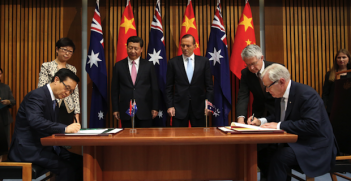Business was Banking on Climate Disaster Even Before US Paris Withdrawal

Trump’s declaration of the US withdrawal from the Paris climate accord has drawn cries of dismay from the corporate world. But a closer look reveals a large number of companies were already banking on climate disaster.
Recently the oil and gas company Santos surprised its stakeholders and observers by admitting that it is preparing for a world that breaks the 2°C guardrail. Chairman Peter Coates told investors at their annual general meeting that “the pathway that we adopt is the four-degree pathway”.
Such a blatant plan to profit from catastrophe is surprising. But it appears to have done little to dissuade some investors. The Australian National University (ANU) is still invested in Santos, despite public pledges to divest from the controversial company as part of its Socially Responsible Investment policy.
But just how unique is the case of Santos? Are many other firms, particularly in the fossil fuel industry, prepared for a world that limits global warming to 1.5°C or 2°C? The truth is very few are.
The idea of ‘stress-testing’ is one way to plan against different climate action scenarios. Stress-testing is a simulation technique which analyses firm performance in different financial conditions. Stress-testing in this case would model the impacts of a global reduction in emissions and fossil fuel demand. Numerous groups, including Ceres and the Investor Group on Climate Change, have been pushing firms, particularly through shareholder resolutions, to conduct 2°C stress-testing and disclose their levels of carbon risk.
Some firms are doing exactly this. BHP Billiton evaluated the impact on their profitability and portfolio of a global accord producing a global carbon price of US$80 (AU$107) per tonne of carbon emitted and subsequent changes to commodity demand. Similarly, Statoil has examined its net present value and profitability against a 2°C scenario.
However, the use of stress-testing doesn’t mean that the company is necessarily planning for a carbon-constrained world. It is usually just one of numerous scenarios. For most major energy companies, modelling is based on a range of different International Energy Agency (IEA) global energy demand scenarios. The ‘450 scenario’ (a world that limits CO2 atmospheric concentrations to 450 parts per million) is sometimes modelled but rarely used as the central scenario for financial forecasting and investment planning.
Stress-testing for internal planning is also sensitive to assumptions. The BHP scenarios relied on unrealistically optimistic outlooks on carbon capture and storage (CCS). Moreover, most modelling and planning tends to rely on short-term horizons only out to 2030. This is a short-sighted approach to planning for a decarbonising world.
Despite some glimmers of hope, most firms have not taken a climate stress test or aligned their planning with a 2°C scenario. BP is relying on forecasts that global fossil fuel use will increase by 33 per cent out to 2035, while Chevron and Shell have largely brushed aside the potential impacts of global climate action on their portfolios.
Carbon Tracker provides one of the few analyses of this topic. Its comparison of the CO2 implication of oil forecasts from different energy companies with the 450 scenario of the IEA shows that none of the major energy companies’ forecasts even approaches the IEA climate action scenario.
Modelling and stress-testing aside, the actions of most firms in the fossil fuel industry suggest they don’t take agreed global goals on climate change seriously. Or that they don’t understand the economics behind the 2°C target.
Any firm undertaking exploration activities for new fossil fuel reserves is not acting in line with the 2°C carbon budget. As it stands, the world cannot use existing reserves without breaking the budget multiple times over. The IEA supports this, stating that “no more than one-third of proven reserves of fossil fuels can be consumed prior to 2050 if the world is to achieve the 2°C goal, unless carbon capture and storage technology is widely deployed.” Most known fossil fuel reserves are unburnable, and exploration for further reserves is wasted expenditure.
Unfortunately, barring a technological miracle, low-cost, retrofittable and widely deployable CCS appears unlikely. A study published in Nature found that the use of CCS does little to limit the amount of unburnable carbon, even if introduced as early as 2025. The cost and limits in application are simply too much to make a large-scale difference.
Companies that are ready for a world of climate action must be willing to allow for numerous reserves to be written-off and to immediately eliminate exploration operations. No major energy firm or provider has indicated that it will do so.
The threat of stranded assets also encompasses electricity generation. A paper published last year by researchers from Oxford University outlined the implications of the 2°C target for electricity generating capital stock. Their conclusion was stark: all new electricity generating infrastructure after 2017 must be zero-carbon. New fossil fuel plants must otherwise be stranded and prematurely retired or retrofitted with CCS.
The pipeline of fossil fuel generators, wells and mines suggests that almost no firm in the fossil fuel industry is prepared for a world of sufficient climate action. It seems unlikely that they believe that stranded assets are a sound business development strategy. Perhaps they sincerely do believe in a miraculous CCS breakthrough. Or perhaps moral hazard is at play: they expect governments to bail them out in the case of a bursting carbon bubble.
For now, the most likely answer appears to be that Santos isn’t alone. Much of the corporate world and fossil fuel industry is banking on the Paris Agreement to fail.
Dr Luke Kemp is a lecturer in climate and environmental policy at the Fenner School of Environment and Society and Crawford School of Public Policy at ANU. He is also a freelance consultant with Vivid Economics.
This article is published under a Creative Commons Licence and may be republished with attribution.





